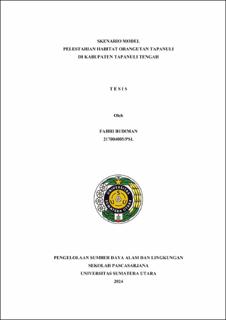Skenario Model Pelestarian Habitat Orangutan Tapanuli di Kabupaten Tapanuli Tengah
Scenario Model for The Conservation of Tapanuli Orangutan Habitat in Tapanuli Tengah Regency

Date
2024Author
Budiman, Fahri
Advisor(s)
Nababan, Esther Sorta Mauli
Metadata
Show full item recordAbstract
This research aims to develop a Scenario Model for the Conservation of the
Tapanuli Orangutan (Pongo tapanuliensis) habitat in the Tapanuli Tengah region
using the DPSIR (Driver, Pressure, State, Impact, Response) framework. The
Model simulation utilizes System Dynamics, and the best scenario is determined
using the Analytical Hierarchy Process (AHP). Four scenarios were compared in
this study: Business As Usual (BAU), threat scenario, policy optimization scenario,
and welfare and rehabilitation scenario. The evaluation was conducted based on
five main criteria: settlements (23,83%), agriculture (31,63%), illegal logging
(2,76%), forest cover change (14,83%), and forest cover (26,94%). The AHP results
indicated that the policy optimization scenario had the highest priority score at
37,61% followed by the welfare and rehabilitation scenario at 36,37%. The threat
and BAU scenarios scored lower, at 11,84% and 14,18%, respectively. These
findings suggest that the policy optimization scenario, involving government
intervention through strict regulations in forest management and habitat
protection, is the best alternative for the conservation of the Tapanuli orangutan.
The welfare and rehabilitation scenario, which integrates ecosystem rehabilitation
with community welfare programs, also presents an effective option. This study
concludes that policy optimization, when integrated with the welfare of local
communities, is the most effective approach to protecting the habitat and
population of the Tapanuli orangutan.
